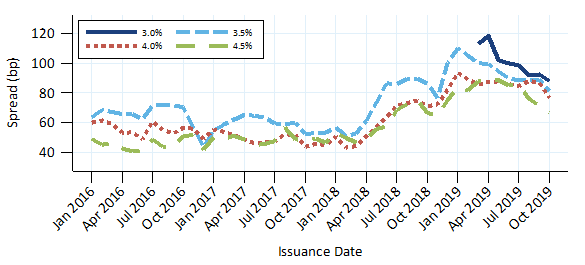Uncategorized
Playing price premiums in specified 30-year 3.0%s
admin | November 1, 2019
This document is intended for institutional investors and is not subject to all of the independence and disclosure standards applicable to debt research reports prepared for retail investors.
At current mortgage rates, conventional 30-year MBS with 3.0% coupons trade above par and account for roughly 50% of current production. Finding interesting value in that flow takes some work, but some specified pools, properly hedged, qualify. Pay-ups on 30-year 3.0% pools with a loan balance story outperform hedges by a projected 7/32s to 12/32s in a 50 bp rally while hedges to the position compensate for lower pay-ups in a sell-off.
Hedging 30-year 3.0% pay-ups
Investors can buy 30-year 3.0% loan balance pools and hedge them 1:1 using FNCL 3.0% TBA. This initially leaves the pay-up unhedged—if rates rise, the pay-up will drop and could eventually approach zero. One solution is to hedge the pay-up using 5-year Treasury notes, using just enough Treasuries compensate for lower pay-ups in a sell-off.
Figuring out how pay-ups might change with rates takes some artwork. A typical approach would look at current pay-ups on the higher and lower coupons. In a 50 bp sell-off, pay-ups on 3.0%s might look like pay-ups on 2.5%s today. In a 50 bp rally, pay-ups on 3.0%s might look like pay-ups on 3.5%s today. Current data for pay-ups on 3.5%s is reliable, so this approach works for estimating pay-ups in a rally. But there is not enough specified pool trading in 2.5%s so a different approach is needed.
An alternative is to look at pay-ups on 3.0%s in a recent environment with higher rates. This occurred when mortgage rates were roughly 50 bp higher in March, April, and May this year. For each specified pool type, enough 5-year notes are shorted to hedge the assumed drop in pay-up. This is shown in Exhibit 1 for loan balance pools with maximum loan sizes of $175,000, $200,000, and $225,000.
Exhibit 1: 3.0% specified pools offer upside in a rally when hedging with 5-year Treasuries

Source: Amherst Pierpont Securities
For example, a Max $175k 3.0% pool is hedged 1:1 with FNCL 3.0% TBA and an additional 20% of 5-year notes. The spot pay-up is 33/32s and would drop to 18/32s—the level from earlier this year—if rates were to rise by 50 bp. On the other hand, in a rally the hedge would lose 15/32s, so the pay-up would be “owned” at 48/32s. However, the current pay-up on a Max $175k 3.5% pool is 60/32s, suggesting that the trade would make 12/32s in this rally scenario.
Pay-ups on 30-year 3.0%s look cheaper than 3.5%s
Comparing actual pay-ups to theoretical pay-ups—calculated using Yield Book’s production prepayment model—illustrates one reason this trade works. Exhibit 2 shows valuations for the three specified pool categories. In the 3.0% coupon the higher loan balance pools are trading between 40% to 50% of theoretical value, but the 3.5% pools are trading between 66% to 79% of theoretical value. This suggests that 3.0% pay-ups will become richer as rates drop, which is consistent with the view that pay-ups will outperform 5-year Treasury hedges.
Exhibit 2: Pay-ups are reasonable for call protection in 3% pools

The TBA is proxied using a high gross WAC multi pool issued earlier in 2019. Each collateral story is run through the production Yield Book model at the same OAS as the corresponding TBA and the price difference to the multi pool is the theoretical pay-up. The specified pools are September issued cash window pools, with the exception of the New York pools (FN B7753 and FN BN7741). Source: Yield Book, Amherst Pierpont Securities
Pools with lower loan balances have better convexity—the loans prepay slower when rates are low and the pool is trading at a premium, and prepay faster when rates are high and the pool is trading at a discount. So these pools offer call protection and extension protection. The average loan size of 3.0% TBA pools is over $300,000 so even a loan with a $225,000 balance has a better prepayment profile than TBA.
Pool gross WACs remain lower after UMBS
The gross WACs of new pools issued under UMBS pooling standards continue to be lower than those issued in late 2018 and before June 2019 (Exhibit 3). A cap on the maximum spread between the gross WAC and pool coupon and a 50 bp cap on the amount of servicing that can be retained has eliminated incentives for originators to sell high WAC loans into low coupon pools. Most pools issued since UMBS have spreads between 85 and 95 bp.
Exhibit 3: Average spreads of new pools are better than late 2018 and early 2019

Average spread between gross WAC and coupon for GSE 30-year pools
Source: Fannie Mae, Freddie Mac, eMBS, Amherst Pierpont Securities


